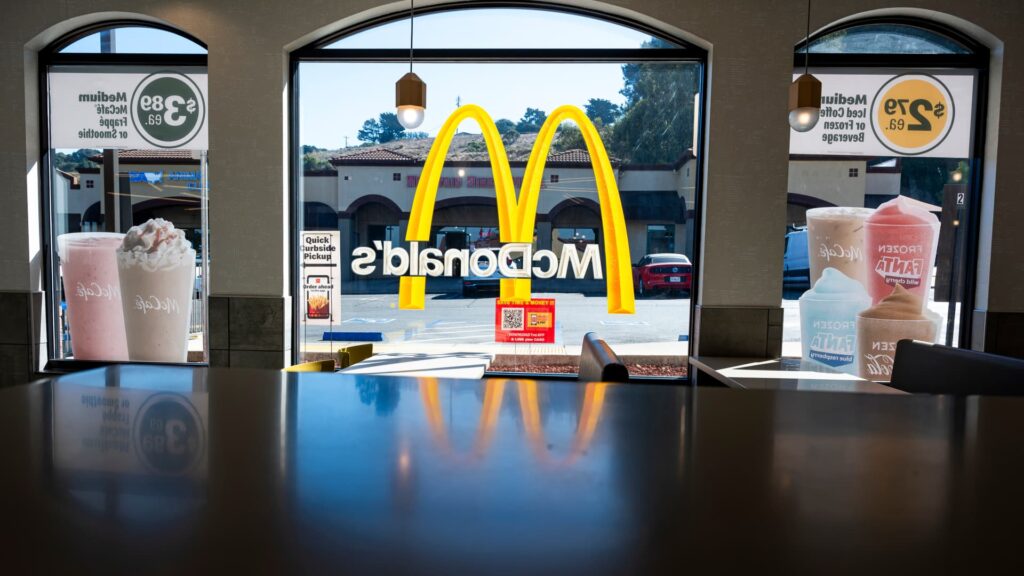October 23, 2024 at a McDonald’s restaurant in El Sobrante, California.
David Paul Morris | Bloomberg | Getty Images
After a tough year for the restaurant industry, executives can’t wait for 2025 to start.
“I don’t know about you, but I’m ready to get through 24 and I think 2025 is going to be a great year,” said Kate Jaspon, CFO of Dunkin’s parent company Inspire Brands. Restaurant Financial Development Conference in Las Vegas this week.
The number of restaurant bankruptcy filings has soared by more than 50% year-over-year so far in 2024. Foot traffic to restaurants open for at least a year fell year-on-year in each month through September, according to data from industry tracker Black Box Intelligence. And many of the country’s largest restaurant chains, mcdonalds to starbuckshas disappointed investors with at least one quarter of declining same-store sales.
But there are some green shoots emerging, increasing lukewarm optimism about the future of the restaurant industry.
Sales have improved from their lowest levels this summer. Customer traffic at fast-food restaurants rose 2.8% in October compared to a year earlier, according to data from Revenue Management Solutions. The company’s data corroborates anecdotal evidence from companies such as Burger King’s owner restaurant brand internationalannounced earlier this month that same-store sales increased in October.
Additionally, interest rates are finally starting to fall. In early November, the Fed approved its second consecutive interest rate cut. For restaurants, lower interest rates make it cheaper to finance new locations and foster growth. Previously, rising interest rates did not have a major impact on development as restaurants were still catching up on the pandemic and riding the height of the post-pandemic sales boom.
A Shake Shack storefront with an illuminated sign on a busy street in New York City, New York on October 22, 2024.
Smith Collection | Gad | Archive Photos | Getty Images
at a hamburger chain shake shackCFO Katie Fogarty said rising interest rates over the past few years have not slowed development. But he expects consumer confidence to “increase significantly” as interest rates fall.
“When credit gets cheaper, people feel like they can borrow more, even though it doesn’t necessarily encourage them to spend on a $5 burger. It’s just the psychology behind it,” Fogerty told CNBC. spoke.
Despite heightened consumer caution, Shake Shack has reported same-store sales growth in every quarter so far this year.
Restaurant valuations have also improved, raising hopes that the initial public offering market may finally thaw.
“We are currently working with various stakeholders to prepare,” said Damon Chandyk, Piper Sandler Managing Director at RFDC. “The window is not wide open right now…I think the bar is particularly high given the traffic pressures we’re seeing across the industry.”
He added that he expects some restaurant IPOs to take place next year, preferably in the first half of the year.
A sign showing the location of Cava Restaurant in Chicago, Illinois on May 28, 2024.
Scott Olson | Getty Images
No major restaurant company has gone public since the Mediterranean restaurant chain. Mr. Hippo IPOed in June last year. Cava’s stock price has risen more than 500% since its debut, but its success hasn’t inspired other large private restaurant companies to take drastic action. Rather, the broader market environment is scaring off other competitors.
Panera Bread secretly filed for a re-public offering nearly a year ago, but the IPO has yet to materialize. Inspire Brands, owned by private equity firm Rourke Capital, is also a likely candidate for a major future IPO. Inspire’s portfolio includes Dunkin’, Buffalo Wild Wings, Jimmy John’s, Sonic, Arby’s and Baskin-Robbins.
Still, the outlook is not all optimistic within the industry.
“I think headwinds will continue next year both within macro and within the industry.” portillo’s CFO Michelle Hook told CNBC.
The fast-casual chain, best known for its Italian beef sandwiches, has reported same-store sales declines for the third consecutive quarter. Portillo’s has avoided some of the discounts offered by other companies in the restaurant industry, such as McDonald’s and Chili’s.
The value war is likely to continue until 2025, squeezing restaurant profits and intensifying competition between chains. McDonald’s, for example, plans to roll out a broader value menu in the first quarter after extending its $5 value menu from summer to winter. The imminent threat of bankruptcy remains for some restaurants, especially chains that rely on discounts to win back customers.
And while a recession seems unlikely next year, it may take longer than expected for consumers to recover from years of high costs.



